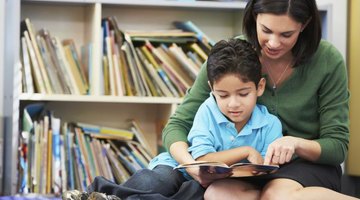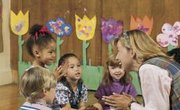Teaching the literature concept of plot to second-graders can help young students prepare for more advanced reading and provide a basis for understanding the narrative function. During second grade, students should develop the ability to describe a story's structure, sequence the events, compare different versions of one plot in multiple stories and use a combination of words and illustrations to understand what is going on, according to Common Core State Standards Initiative.
Take-Home Journal
Even though reading a story and picking out the plot can help second-graders to better understand this literary concept, getting hands-on and creating their own tale is a fun way to effectively teach this idea. Read a story that features a favorite character or an animal with human-like qualities. Start a class journal in a notebook, in which the students create their own story that carries on the plot of the original. Each week send home a stuffed animal or doll that matches the main character. Ask the student who has the toy to add on to the story, extending the plot by telling what the character did during the week. For example, read "Harry the Dirty Dog" by Gene Zion, and send home a stuffed dog toy. Students continue the plot by writing about what Harry did with them, new friends that he met and where he went.
Same Story, Different Name
Second-graders are developing the ability to understand that more than one book or story can have the same plot. Play up this concept with a fun-filled comparison activity. Pick two stories that have a similar plot. For example, choose two books that tell the tale of a little girl who was scared to go to school on the first day. Make a chart on poster paper with two columns, one for each story. Ask students to pick out the sequence of each story, the main characters and the settings. List these in the appropriate columns on the chart. Switch some of the elements -- such as the character's names or places -- and ask the students if the story still makes sense.
Cultural Context
Add another layer to learning about plot by using folktales and stories from different cultures. Folktales can help second-graders understand narrative concepts while exploring customs, beliefs and activities from around the world. Pick a tale such as "Anansi the Spider: A Tale From the Ashanti" by Harcourt School Publishers or a collection such as "Korean Children's Favorite Stories" by Kim So-Un. Discuss how folktales are passed down from one generation to the next and how the plot usually contains a moral or consequence. Have the class create a folktale, picking characters, setting and moral.
Picture It
By second grade, students can use pictures and words together to understand a plot. After reading a story, ask students to draw the plot. Pick a book that doesn't have pictures, allowing students to play illustrators. Display the pictures in the classroom and re-read the story to see and hear the plot together.
Related Articles
References
Writer Bio
Based in Pittsburgh, Erica Loop has been writing education, child development and parenting articles since 2009. Her articles have appeared in "Pittsburgh Parent Magazine" and the website PBS Parents. She has a Master of Science in applied developmental psychology from the University of Pittsburgh's School of Education.











